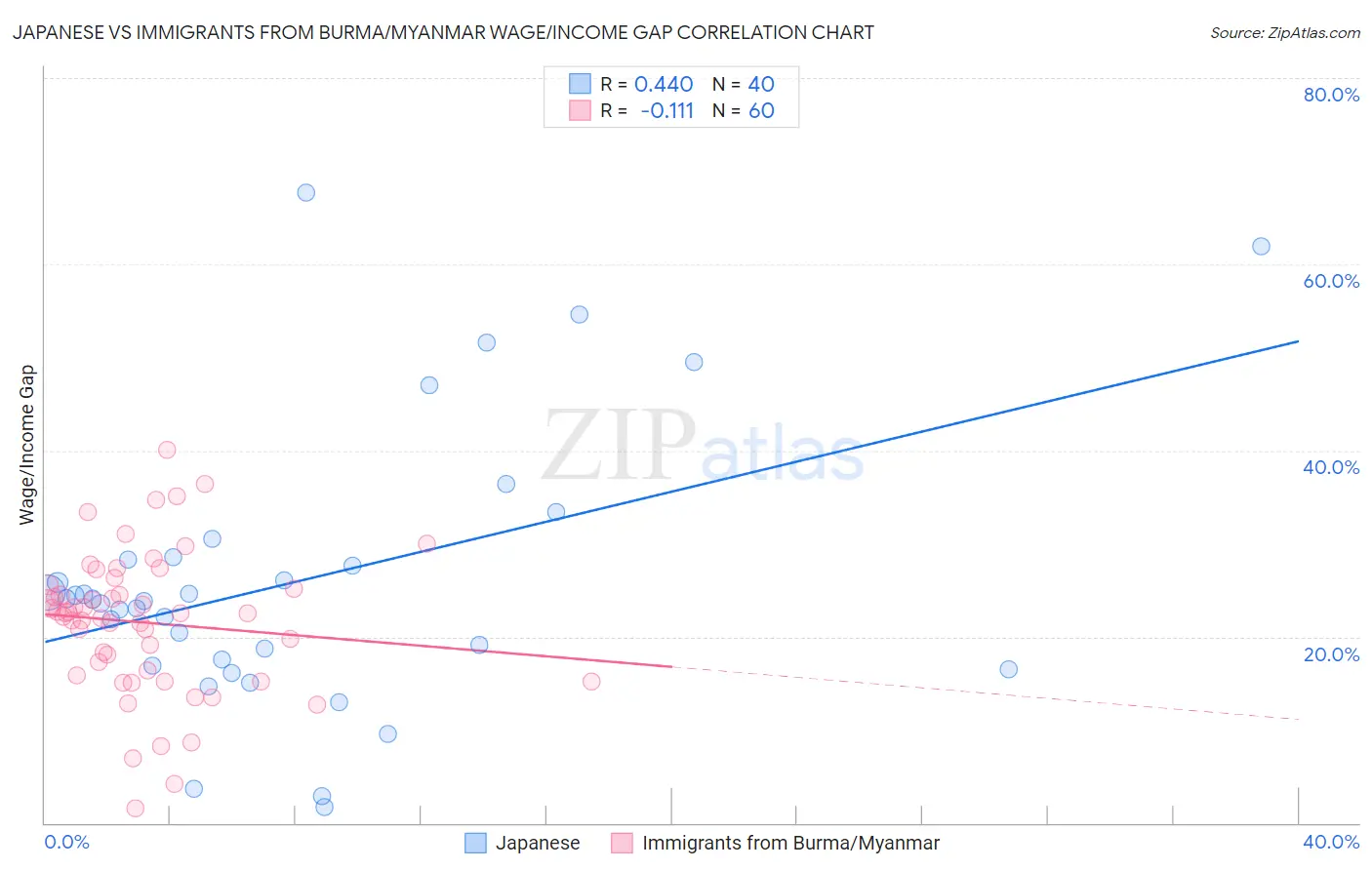Japanese vs Immigrants from Burma/Myanmar Wage/Income Gap
COMPARE
Japanese
Immigrants from Burma/Myanmar
Wage/Income Gap
Wage/Income Gap Comparison
Japanese
Immigrants from Burma/Myanmar
23.8%
WAGE/INCOME GAP
99.1/ 100
METRIC RATING
101st/ 347
METRIC RANK
22.8%
WAGE/INCOME GAP
99.9/ 100
METRIC RATING
74th/ 347
METRIC RANK
Japanese vs Immigrants from Burma/Myanmar Wage/Income Gap Correlation Chart
The statistical analysis conducted on geographies consisting of 249,130,971 people shows a moderate positive correlation between the proportion of Japanese and wage/income gap percentage in the United States with a correlation coefficient (R) of 0.440 and weighted average of 23.8%. Similarly, the statistical analysis conducted on geographies consisting of 172,335,436 people shows a poor negative correlation between the proportion of Immigrants from Burma/Myanmar and wage/income gap percentage in the United States with a correlation coefficient (R) of -0.111 and weighted average of 22.8%, a difference of 4.1%.

Wage/Income Gap Correlation Summary
| Measurement | Japanese | Immigrants from Burma/Myanmar |
| Minimum | 1.7% | 1.6% |
| Maximum | 67.8% | 40.1% |
| Range | 66.0% | 38.6% |
| Mean | 26.0% | 21.5% |
| Median | 23.9% | 22.5% |
| Interquartile 25% (IQ1) | 17.2% | 16.1% |
| Interquartile 75% (IQ3) | 28.4% | 25.3% |
| Interquartile Range (IQR) | 11.2% | 9.2% |
| Standard Deviation (Sample) | 14.8% | 7.6% |
| Standard Deviation (Population) | 14.6% | 7.6% |
Similar Demographics by Wage/Income Gap
Demographics Similar to Japanese by Wage/Income Gap
In terms of wage/income gap, the demographic groups most similar to Japanese are Immigrants from Laos (23.8%, a difference of 0.14%), Yakama (23.7%, a difference of 0.15%), Aleut (23.7%, a difference of 0.17%), Immigrants from Latin America (23.7%, a difference of 0.25%), and Tsimshian (23.9%, a difference of 0.37%).
| Demographics | Rating | Rank | Wage/Income Gap |
| Hondurans | 99.5 /100 | #94 | Exceptional 23.6% |
| Cape Verdeans | 99.4 /100 | #95 | Exceptional 23.6% |
| Kiowa | 99.4 /100 | #96 | Exceptional 23.6% |
| Immigrants | Sudan | 99.4 /100 | #97 | Exceptional 23.6% |
| Immigrants | Latin America | 99.2 /100 | #98 | Exceptional 23.7% |
| Aleuts | 99.2 /100 | #99 | Exceptional 23.7% |
| Yakama | 99.2 /100 | #100 | Exceptional 23.7% |
| Japanese | 99.1 /100 | #101 | Exceptional 23.8% |
| Immigrants | Laos | 99.0 /100 | #102 | Exceptional 23.8% |
| Tsimshian | 98.9 /100 | #103 | Exceptional 23.9% |
| Tlingit-Haida | 98.7 /100 | #104 | Exceptional 24.0% |
| Moroccans | 98.6 /100 | #105 | Exceptional 24.0% |
| Sudanese | 98.6 /100 | #106 | Exceptional 24.0% |
| Yaqui | 98.4 /100 | #107 | Exceptional 24.0% |
| Immigrants | Albania | 98.4 /100 | #108 | Exceptional 24.0% |
Demographics Similar to Immigrants from Burma/Myanmar by Wage/Income Gap
In terms of wage/income gap, the demographic groups most similar to Immigrants from Burma/Myanmar are Immigrants from Eastern Africa (22.8%, a difference of 0.080%), Subsaharan African (22.8%, a difference of 0.11%), Immigrants from El Salvador (22.8%, a difference of 0.26%), Fijian (22.9%, a difference of 0.28%), and Ecuadorian (22.9%, a difference of 0.30%).
| Demographics | Rating | Rank | Wage/Income Gap |
| Menominee | 99.9 /100 | #67 | Exceptional 22.7% |
| Immigrants | Nigeria | 99.9 /100 | #68 | Exceptional 22.7% |
| Indonesians | 99.9 /100 | #69 | Exceptional 22.7% |
| Immigrants | Uzbekistan | 99.9 /100 | #70 | Exceptional 22.7% |
| Immigrants | El Salvador | 99.9 /100 | #71 | Exceptional 22.8% |
| Sub-Saharan Africans | 99.9 /100 | #72 | Exceptional 22.8% |
| Immigrants | Eastern Africa | 99.9 /100 | #73 | Exceptional 22.8% |
| Immigrants | Burma/Myanmar | 99.9 /100 | #74 | Exceptional 22.8% |
| Fijians | 99.9 /100 | #75 | Exceptional 22.9% |
| Ecuadorians | 99.9 /100 | #76 | Exceptional 22.9% |
| Africans | 99.9 /100 | #77 | Exceptional 22.9% |
| Nigerians | 99.9 /100 | #78 | Exceptional 23.0% |
| Immigrants | Nicaragua | 99.9 /100 | #79 | Exceptional 23.0% |
| Salvadorans | 99.9 /100 | #80 | Exceptional 23.0% |
| Bermudans | 99.8 /100 | #81 | Exceptional 23.1% |